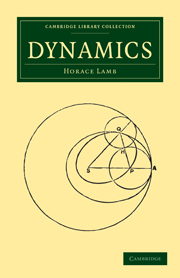Book contents
- Frontmatter
- PREFACE
- Contents
- CHAPTER I KINEMATICS OF RECTILINEAR MOTION
- CHAPTER II DYNAMICS OF RECTILINEAR MOTION
- CHAPTER III TWO-DIMENSIONAL KINEMATICS
- CHAPTER IV DYNAMICS OF A PARTICLE IN TWO DIMENSIONS. CARTESIAN COORDINATES
- CHAPTER V TANGENTIAL AND NORMAL ACCELERATIONS. CONSTRAINED MOTION
- CHAPTER VI MOTION OF A PAIR OF PARTICLES
- CHAPTER VII DYNAMICS OF A SYSTEM OF PARTICLES
- CHAPTER VIII DYNAMICS OF RIGID BODIES. ROTATION ABOUT A FIXED AXIS
- CHAPTER IX DYNAMICS OF RIGID BODIES (CONTINUED). MOTION IN TWO DIMENSIONS
- CHAPTER X LAW OF GRAVITATION
- CHAPTER XI CENTRAL FORCES
- CHAPTER XII DISSIPATIVE FORCES
- CHAPTER XIII SYSTEMS OF TWO DEGRESS OF FREEDOM
- APPENDIX. NOTE ON DYNAMICAL PRINCIPLES
- INDEX
APPENDIX. NOTE ON DYNAMICAL PRINCIPLES
Published online by Cambridge University Press: 07 September 2010
- Frontmatter
- PREFACE
- Contents
- CHAPTER I KINEMATICS OF RECTILINEAR MOTION
- CHAPTER II DYNAMICS OF RECTILINEAR MOTION
- CHAPTER III TWO-DIMENSIONAL KINEMATICS
- CHAPTER IV DYNAMICS OF A PARTICLE IN TWO DIMENSIONS. CARTESIAN COORDINATES
- CHAPTER V TANGENTIAL AND NORMAL ACCELERATIONS. CONSTRAINED MOTION
- CHAPTER VI MOTION OF A PAIR OF PARTICLES
- CHAPTER VII DYNAMICS OF A SYSTEM OF PARTICLES
- CHAPTER VIII DYNAMICS OF RIGID BODIES. ROTATION ABOUT A FIXED AXIS
- CHAPTER IX DYNAMICS OF RIGID BODIES (CONTINUED). MOTION IN TWO DIMENSIONS
- CHAPTER X LAW OF GRAVITATION
- CHAPTER XI CENTRAL FORCES
- CHAPTER XII DISSIPATIVE FORCES
- CHAPTER XIII SYSTEMS OF TWO DEGRESS OF FREEDOM
- APPENDIX. NOTE ON DYNAMICAL PRINCIPLES
- INDEX
Summary
Although the day is long past when there could be any serious difference of opinion as to whether a particular solution of a dynamical question is or is not correct, the proper formulation of the principles of Dynamics has been much debated, and especially in recent times.
To a student still at the threshold of the subject the most important thing is that he should acquire as rapidly as possible a system of rules which he can apply without hesitation, and, so far as his mathematical powers will allow, with success, to any dynamical question in which he may be interested. From this point of view it is legitimate, in expounding the subject, to take advantage of such prepossessions which he may have as are serviceable, whilst warning him against others which may be misleading. This is the course which has been attempted in the present work, as in most elementary accounts of the subject.
But if at a later stage the student, casting his glance backwards, proceeds to analyse more closely the fundamental principles as they have been delivered to him, he may become aware that there is something unsatisfactory about them from a formal, and even from a logical standpoint. For instance, it is asserted, as an induction from experience, that the velocity of a body not acted on by any force will be constant in magnitude and direction, whereas the only means of ascertaining whether a body is, or is not, free from the action of force is by observing whether its velocity is constant.
- Type
- Chapter
- Information
- Dynamics , pp. 345 - 349Publisher: Cambridge University PressPrint publication year: 2009First published in: 1923

